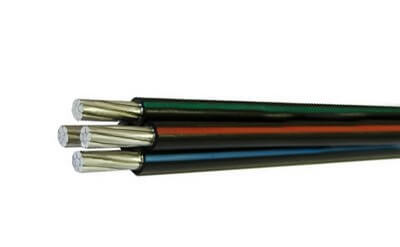Types, characteristics and differences of SIP wires
How to decipher
First of all, it should be noted that the decoding of the SIP marking is as follows:
- C - self-supporting;
- And - isolated;
- P - wire.
Please note that according to the abbreviation, this is still a wire, not a cable, which many consider it to be.
I would also like to note that the prefix “A” at the end of the marking (for example, SIP-1A), indicates that the zero core is covered with insulation. The prefix “n”, in turn, means that the current-carrying conductors are made of aluminum alloy, and the letter “t” at the end of the mark indicates that the insulation is resistant to elevated temperatures + 90 ° C (for a short time + 120 ° C).
Design
Before considering the device of the SIP wire, I would like to say that today there are the following brands of conductor: SIP-1, -1A, -2, -2A, -3, -3, -4, -5. The types and differences of each brand we will provide now.
SIP-1 is produced for 380 V networks. This is a four-wire cable made of aluminum or aluminum alloy, three cores are coated with UV-resistant polyethylene, and the fourth without a braid with a steel core, serves as a carrier and neutral.
At SIP-2, all cores are isolated, bearing, including.
SIP-3 is a single-core steel-aluminum cable with a sheath made of cross-linked light-stabilized polyethylene.
At SIP-4, all four conductors are insulated with thermoplastic light-stabilized polyethylene, but there is no supporting separate core.
SIP-5 also does not have a separate supporting core, the rest are covered with a cross-linked polyethylene sheath, the number of cores is two or more.
According to the technical characteristics of SIP-1, SIP-2, SIP-4 and SIP-5 are designed for rated voltage up to 1 kV, SIP-3 up to 35 kV.
Of the remaining parameters, I would like to highlight:
- operating temperature range from -60 to + 50 ° С;
- climatic modification of UHL (moderately cold climate);
- installation of the line is possible at -10 degrees Celsius;
- Warranty period of operation 5 years;
- declared service life of at least 45 years.
For more information on the characteristics of SIP, such as the minimum bending radius, resistance, current load, mass and cross-section of conductors, see the tables:
Laying conditions
Wire routing does not require special skills. Via fittings for installation of self-supporting insulated wire almost anyone can handle this by reading the rules.
We provide a surface overview of the installation of a self-supporting insulated wire. On the support, with special metal clips, fasteners for anchors are installed, which will hold special clamps. The self-supporting insulated wire is started on the supports by the pulling method, first roll-up rollers are installed on the poles, with a protective layer of plastic to prevent damage to the insulation of the drawn cable and they are stretched in advance by the leader rope, reeling from the reel.
When mounting, you must avoid dragging along the ground and tree branches. Using a dynamometer establish the permissible line tension. After that, the wire is fixed in the spans. Docking and withdrawal of the line is carried out with hermetic clamps. Electrical contact is carried out by piercing the protective layer with spikes. Connection can be energized, design piercing clamp allows you to perform this procedure safely.
The process of installing the SIP wire is considered in detail in the video below:
Application area
As we said above, it is customary to use a self-supporting insulated wire in networks up to 35 kV. Most often it is used in highways of overhead power lines, as well as for branches from overhead lines to enter buildings. If you want to to conduct electricity to the site, then in this case, you just need the SIP wire, with which you can organize input at the cottage or in a private house. In addition, this conductor is used for outdoor lighting.
By the way, there are analogues of SIP. For example, the Finnish conductor AMKA is an analogue of SIP-1. Instead of SIP-2, you can use the French wire brand Torsada. The analogue of SIP-3 is another Finnish conductor - SAX or the Polish PAS-W. Well, as for the SIP-4 / SIP-5 brands, they can be replaced with wires developed according to Swedish technology - EX Four Core ALUS or PolishAsXsn.
Manufacturers
The last thing I would like to talk about when considering the technical characteristics of the SIP wire is which manufacturers are the highest quality today. Of the domestic manufacturers, the following products have the highest quality products:
- LLC "Kama cable";
- Rybinskkabel OJSC;
- LLC GK Sevkabel;
- CJSC Moskabel Plant.
Using the products of these manufacturers, the chance to get on a fake or poor-quality conductor is very small. However, if you doubt that the product brand you have chosen complies with GOST, we recommend that you perform a simple check - determine the cable cross-section by the diameter of the core.
That's all I wanted to tell you about the technical characteristics of the SIP wire, as well as its types and differences. We hope the information provided was useful to you!
It will be useful to read:





















How far has progressed in electricity. It used to be a whole web of wires, but now one cable hangs neatly. And in the master cable you can find sip cables and fittings and everything that relies on this.